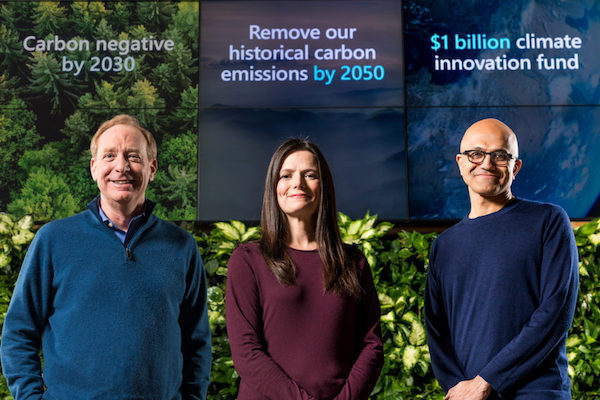Creator
Microsoft is a US based international technology company that produces both software and hardware. They are best known for their Microsoft Office software suite, Xbox video game consoles and the Microsoft Surface touchscreen computers.
Purpose
“The scientific consensus is clear. The world confronts an urgent carbon problem. The carbon in our atmosphere has created a blanket of gas that traps heat and is changing the world’s climate. Already, the planet’s temperature has risen by 1 degree centigrade. If we don’t curb emissions, and temperatures continue to climb, science tells us that the results will be catastrophic.”

Manifesto
While the world will need to reach net zero, those of us who can afford to move faster and go further should do so. That’s why today we are announcing an ambitious goal and a new plan to reduce and ultimately remove Microsoft’s carbon footprint.
By 2030 Microsoft will be carbon negative, and by 2050 Microsoft will remove from the environment all the carbon the company has emitted either directly or by electrical consumption since it was founded in 1975.
We recognize that progress requires not just a bold goal but a detailed plan. As described below, we are launching today an aggressive program to cut our carbon emissions by more than half by 2030, both for our direct emissions and for our entire supply and value chain. We will fund this in part by expanding our internal carbon fee, in place since 2012 and increased last year, to start charging not only our direct emissions, but those from our supply and value chains.
Taking a Principled Approach
Whenever we take on a new and complex societal issue, we strive first to learn and then to define a principled approach to guide our efforts. This has been fundamental to our work around the protection of privacy and the ethical development of artificial intelligence, and it’s the approach we’re taking to pursue our aggressive carbon goals as well. We’ve concluded that seven principles, or elements, will be vital as we continually innovate and take additional steps on an ongoing basis.
- Grounding in science and math. We will continually ground our work in the best available science and most accurate math, as we describe further below.
- Taking responsibility for our carbon footprint. We will take responsibility for all our emissions, so by 2030 we can cut them by more than half and remove more carbon than we emit each year.
- Investing for new carbon reduction and removal technology. We will deploy $1 billion of our own capital in a new Climate Innovation Fund to accelerate the development of carbon reduction and removal technologies that will help us and the world become carbon negative.
- Empowering customers around the world. Perhaps most importantly, we will develop and deploy digital technology to help our suppliers and customers reduce their carbon footprints.
- Ensuring effective transparency. We will publish an annual Environmental Sustainability Report that provides transparency on our progress, based on strong global reporting standards.
- Using our voice on carbon-related public policy issues. We will support new public policy initiatives to accelerate carbon reduction and removal opportunities.
- Enlisting our employees. We recognize that our employees will be our biggest asset in advancing innovation, and we will create new opportunities to enable them to contribute to our efforts.
Source
https://blogs.microsoft.com/blog/2020/01/16/microsoft-will-be-carbon-negative-by-2030/
https://en.wikipedia.org/wiki/Microsoft
Thanks to Carolyn Butler-Madden for sharing this with me.
Comment
This is a great example of a manifesto in action – and a good model to follow.
It starts with the motivation: “The world confronts an urgent carbon problem.”
Next is the declaration that says – this is what we are going to do about this: “By 2030 Microsoft will be carbon negative.”
Then to turn the idea into a plan, Microsoft have identified 7 key principles to follow.
The principles are the strategy for how Microsoft will become carbon negative by 2030.
This includes the key point of who is going to be involved here and what we need to do to engage and support them – empower customers, enlist employees and importantly use their voice to lead the conversation.
Finally, they point to big opportunity as impacting their entire supply chain. It’s not just a ‘we’ll look after our own backyard’ approach. Instead, it’s a holistic and ultimately collaborative approach.
This is leadership!
More
Renewable UK – Cymru Renewable Energy Manifesto
